Text
The Entirety of Japanese, Lesson #1
AKA - I'm sorry, you do have to learn all three scripts.
Welcome to our first lesson! Today, we are going to learn how to read Japanese.
Sort of.
See, it's not something you can learn in one day, or one lesson. Learning a language is a gradual process that doesn't cement until you start *using* it.
So we will go over the basics, both the WHY three scripts and the HOW to learn all three over time, and then provide 10+ FREE resources from all over the internet for you to practice with!
Let's go!
Why All Three Scripts?
Short answer: because I said so.
Kidding.
The Japanese language has no spaces in it. Unlike English where there is a space between each word, Japanese sentences look like this:
スモモも桃も桃のうち
All three scripts are in this sentence. It translates to "plums and peaches are both like peaches". An odd sentence, but here's why I chose it...
When you write it in *just* Hiragana (the basic, "first" phonetic script), it looks like this:
すもももももももものうち
Yikes. So many も, with no way to tell apart the multiple words in the も train.
So... how can you tell similar words apart when written out?
Wait, let's look back a bit. Can you tell where different words are in the sentence before? Yes. Even without being taught *anything* about the Japanese language, you can tell where different words start just by looking at it.
By writing in multiple scripts, you can tell similar words apart.
Okay... But How Do I Learn Them?
There's quite a few ways to learn them. In fact, on Thursday we will be publishing community responses from our Discord detailing how THEY learned the scripts.
But for now, here is the two first scripts you'll learn in their entirety, thanks to Coto Japanese Acamedy
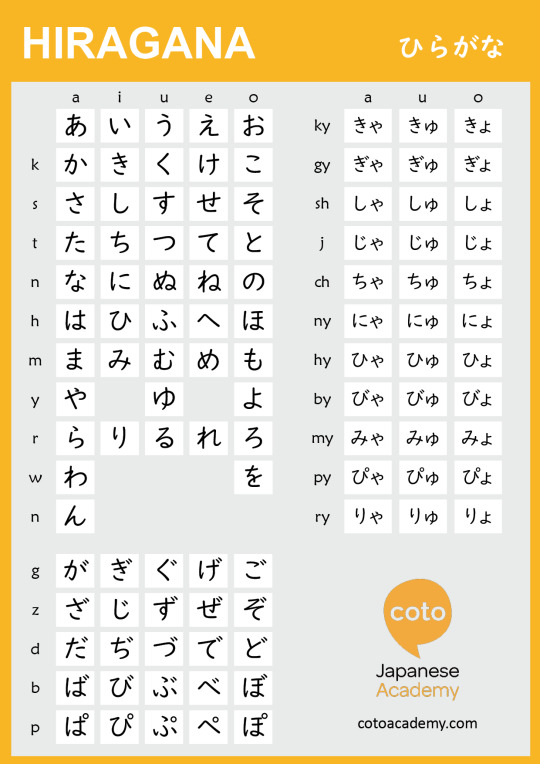

You'll learn these first for three reasons:
First, they are easier.
Second, you can spell any word in Japanese with these two scripts. Not a hard and fast rule, but Hiragana is used for native Japanese words and Katakana is usually used for international loan words, emphasis, names, and 'sound effect words', aka onomatopoeia.
Third, you'll see Hiragana above Kanji (the difficult one) that tells you how to pronounce Kanji.
As far as actually learning them, you *could* just write them down over and over.
Writing is super important when learning Japanese.
But it might be easier to start with some apps, games, and videos where you can learn the characters both in context AND within words.
Here's our favorite FREE resources:
Duolingo (Website, Android, and Apple) is great for learning singular words and Hiragana / Katakana, however explanations of grammar is limited to desktop. Still, PERFECT for the beginning stages regardless of device.
Bunpo is another free app for learning Japanese!
JapanesePod101's videos on Hiragana and Katakana over on Youtube are fantastic for hearing natural speach.
Tofugu's Hiragana and Katakana blog posts have the * best * mnemomics, with sound bites.
Busuu's (Website, Android, Apple) Japanese course starts off with Hiragana words to get you speaking immediately.
Kana (Apple, Android) is a free app dedicated to JUST Hiragana and Katakana.
Tae Kim's Guide to Learning Japanese is the holy grail for new Japanese learners. Of course, it has a no-frills explanations of all three scripts.
Japanese Ammo with Misa has detailed lessons on everything, including Kana.
Here's a video on the difference between printed and written Hiragana fonts.
And finally... our discord server.
Wait... what about Kanji?
Well, the problem is there's a lot to learn. A LOT.
You'll be learning them over the course of yearssssssss. But that's fine; you can tune into our lessons to learn them.
Join right here to practice what you learn! You'll also gain access to new friends learning the same language AND more free resources.
We can't wait to see you there!
#japan#japanese#japanese language#learn japanese#japanese studyblr#nihongo#japan travel#japanese culture#japan trip#anime and manga#anime#anime art
188 notes
·
View notes
Text


25/06/2023
got a new book today! this one contains short stories from a bunch of authors including Haruki Murakami and Banana Yoshimoto. really looking forward to starting it after I finish the LingoMastery Japanese short stories collection!
320 notes
·
View notes
Text
冷静
れいせい
calmness, composure, coolness, serenity, presence of mind
冷静に考えて見ろよ!
れいせい に かんがえて みろ よ!
Be realistic!

50 notes
·
View notes
Text
How to gain access to the Seitokai Discord server
Hi, friends! It's @onigiriforears (aka shay) here! I'm going to teach you how to gain access to our entire server. Step by step.
Step 1: The first message and channel that you'll see when you enter the server is in the #welcome channel. It'll look something like this:
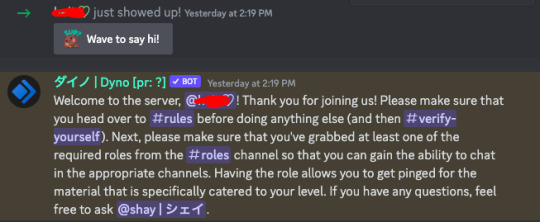
Step 2: Please follow the directions and head over to the #rules channel. This channel is going to make sure that you understand the rules and guidelines of the server. It's imperative that you read it because even though this is a server focused on learning and free resource sharing, we're a community server that's trying to make sure that we don't violate Discord's guidelines. READ THEM IN ENTIRETY. If you're confused, feel free to message me on Discord (I'm the "shay" that's mentioned/pinged in your welcome message. I know you're in the server--I allow the server's notifications to push through my DND settings.) You could also message me or send me an ask @onigiriforears, but discord will get you a faster response.

Step 3: From there, please go to the #verify-yourself channel. In this channel, you'll be confirming that you didn't lie about actually reading the #rules. We (me, mods, and admin) can tell if you're lying based off of what #roles you have (or don't have). Why do we have it set up this way? We're trying to discourage trolls and bots from entering the server. Because, unfortunately, we have been raided and trolled more than once. Some specific moments would be when someone broke through our (at the time) low-key "pick a role" option and stole our roster list. They used it to find mutual servers that they shared with members and then harassed them in the mutual servers after being banned in ours. (That included stealing ppl's stuff in the dank meme bot and whatnot.) A second time would be when someone broke through our mandatory #roles and spammed channels and told everyone that people who can't get to N1 in a year are dumb <not a good look. He was promptly banned lmao.

Step 4: Head over to the #roles channel. IT'S SO IMPORTANT. This is where you'll have to choose the one role that's mandatory--every other role within that channel is optional besides the JLPT level roles. Why? Since we're a community server focused on resource sharing and engagement, we also make sure we pay attention to our server demographics. If we have a slew of N5 or beginning members, we make sure that we have a lot of N5-targeted events and resources available. For a while, we had no N2 and N1 members, so we were able to hold off on posting kanji for the levels for a bit while we focused on something else. Now, we have a good mixture.

Step 5: ENJOY THE SERVER! If you've properly followed steps 1-4, you'll have gained access to the entire server. If not, please message me or you might find yourself in server purgatory where we ping you to get your attention until you either ask for help or you follow through lmao--aka the #temp channel. It's a private channel that only admin and other purgatory-dwellers can see. Once you get your appropriate roles, the channel disappears for you.

If you're thinking, this is a pain of a way to get in: it was a pain for me to set it up like this, too. Trial and error over almost 2 years of being a server. I can say that after setting it up this way, we haven't had anymore trolls or bots enter.
#japanese#japanese studyblr#langblr#seitokai#seitokai discord server#seitokai server#learn japanese#study japanese#look toki#jpnstudynet#nihongo#nihon#bilingualism#bilingual#linguistics#japan#japanese language#polyglot#studyspo#studyblr
59 notes
·
View notes
Text

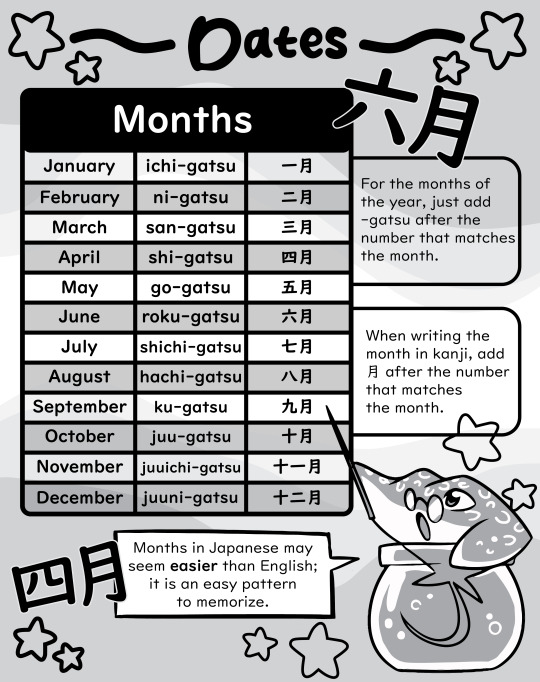
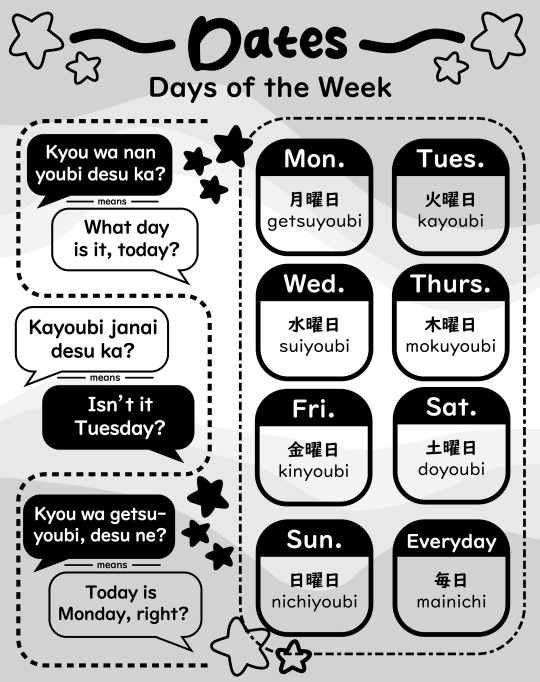

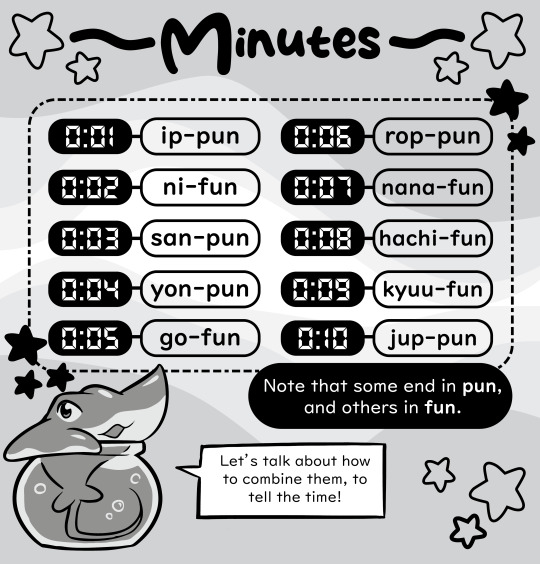
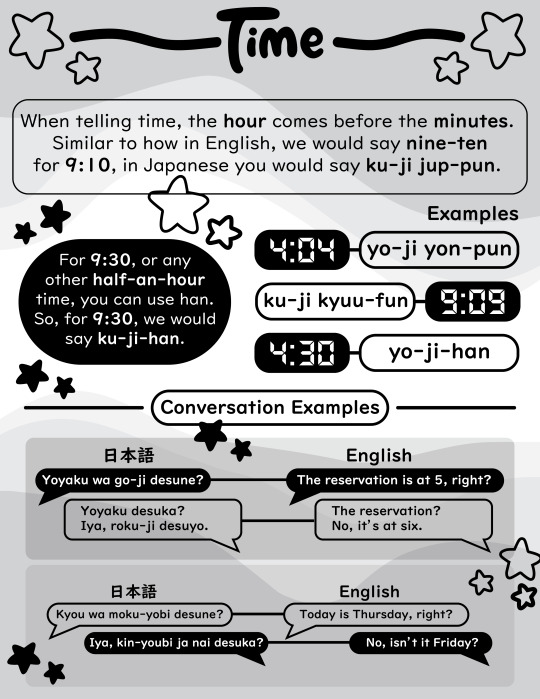
Download our free textbook to learn hiragana here!
283 notes
·
View notes
Text
thanks for the reblog boo boo <3 it's about to be a language learning party up in here
Learning a language is more accessible than it's ever been
Really.
There's such a wide variety of free lessons, resources, communities, and language exchanges.
This is especially true for Japanese and other languages not commonly taught in schools.
We've been running a mildly successful Discord server for a few years now (500+ members), but now we want to use our knowledge and experience to provide *free* lessons, utilizing *free* resources in every format possible, which will eventually span from N5-N1 fluency levels.
Our lesson posts will have "homework", which are apps, websites, or Youtube videos you can use to practice what you have learned, which you can pick and choose what homework format you prefer.
Don't want to download Duolingo for our first lesson's practice? Watch JapanesePod101's Youtube video on the topic instead. Don't like that? Try the link to Tofugu which covers the same topics as our lesson.
We will also cover topics such as language exposure when you can't visit the country, exercises, community games held on our Discord (we're working on Japanese Trivia Monopoly for N5 right now), streams, and more just like we always have in our Discord server!
Ready to learn Japanese, for free, regardless of skill level?
Here's the link to sign up to our Discord server.
We can't wait to see you there!
またね~

233 notes
·
View notes
Text
呆れる 「あきれる」 to be amazed
罵倒される 「ばとうされる」 to be abused, to be vilified
嘲り 「あざけり」 ridicule, scorn
翳る 「かげる」 to darken, to worsen
杖 「つえ」 cane, wand
陽 「ひ」 sun, sunshine
微笑む 「ほほえむ」 to smile
半白 「はんじろ」 partly grey
細々 「こまごま」 minutely
姉弟 「きょうだい」 siblings (older sister younger brother)
面影 「おもかげ」 face, countenance
訊く 「きく」 to ask, to enquire
秤 「はかり」 scales
肥る 「ふとる」 to put on weight
手許 「てもと」 nearby, at hand
厄介 「やっかい」 burden
強面 「こわもて」 fierce look
濁声 「だみごえ」 husky voice
達磨 「だるま」 Daruma
白髪交じり 「しらがまじり」 hair streaked with grey
傍らに 「かたわらに」 beside, nearby
窘める 「たしなめる」 to chide
杞憂 「きゆう」 unfounded worry
躾 「しつけ」 discipline

144 notes
·
View notes
Text
Pitch, Please Pt. 1 [new series alert]

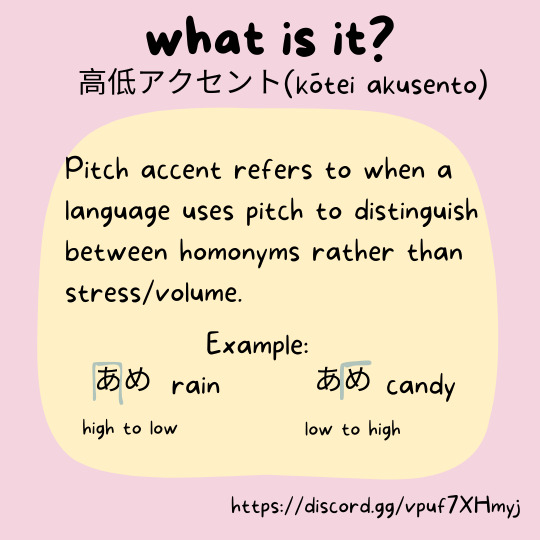
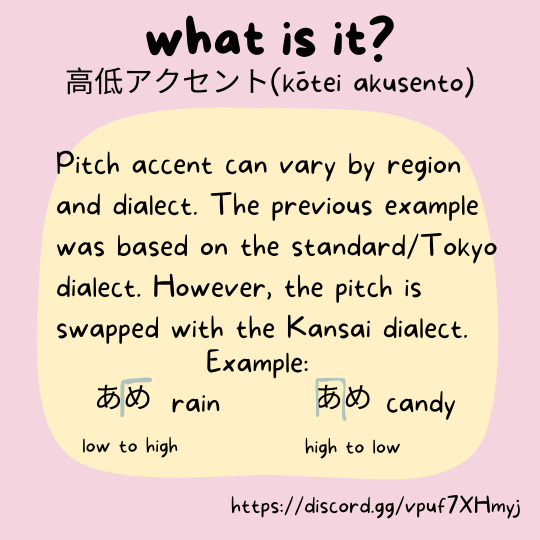


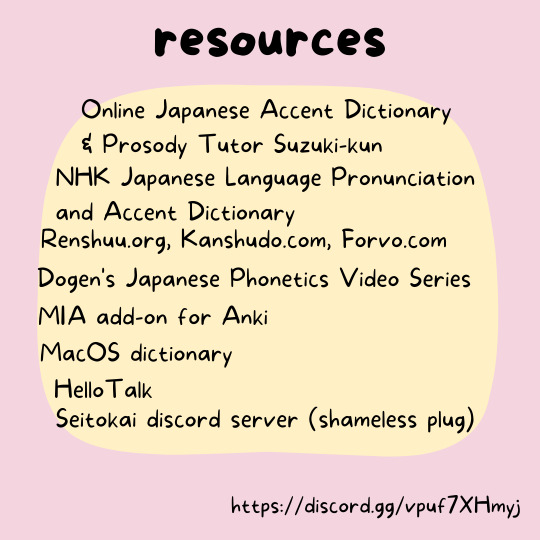

This was launched on the Seitokai IG (seitokaisnihongo). Keep reading this post to get information that is written on the graphics (and the IG caption).
This is a new series that I've been working on for a bit! It'll be discussing pitch accent, dialects, listening comprehension, and anything else that may fall within that category.
If there's a particular dialect that you'd like for us to cover in this series, feel free to stick it in the reblogs, my inbox, my asks, on the Seitokai instagram, or the Seitokai discord server!
Without further ado, here is what the posts say above!
Pitch, Please! Let's talk about pitch accent.
What is it?
Pitch accent, known as 高低アクセント(kōtei akusento) in Japanese, refers to when a language uses pitch to distinguish between homonyms rather than stress/volume. For example: あめ, meaning rain (high pitch to low) vs あめ, meaning candy (low pitch to high pitch).
Pitch accent can vary by region and dialect. The previous example was based on standard/Tokyo dialect. However, the pitch accent is swapped with the Kansai dialect. あめ, meaning rain goes from low pitch to high and あめ, meaning candy goes from high pitch to low.
There are four (4) pitch accent patterns: 平板 (へいばん), 頭高 (あたまだか), 中高 (なかだか), and 尾高 (おだか). These will be discussed in further detail in a later post within this series.
How to work on it?
Listen to native speakers (podcasts, news channels, videos, etc.)
Converse with native speakers (if possible)
Mimic the correct pronunciation
Be willing to ask for help and accept correction
Resources
Online Japanese Accent Dictionary & Prosody Tutor Suzuki-kun
NHK Japanese Language Pronunciation and Accent Dictionary
Renshuu.org, Kanshudo.com, Forvo.com
Dogen's Japanese Phonetics Video Series
MIA add-on for Anki
MacOS dictionary
HelloTalk
If you're looking for fellow learners, there are over 500 of us in the Seitokai discord server (shameless plug) and we'd love to have you!
234 notes
·
View notes
Text
Learning a language is more accessible than it's ever been
Really.
There's such a wide variety of free lessons, resources, communities, and language exchanges.
This is especially true for Japanese and other languages not commonly taught in schools.
We've been running a mildly successful Discord server for a few years now (500+ members), but now we want to use our knowledge and experience to provide *free* lessons, utilizing *free* resources in every format possible, which will eventually span from N5-N1 fluency levels.
Our lesson posts will have "homework", which are apps, websites, or Youtube videos you can use to practice what you have learned, which you can pick and choose what homework format you prefer.
Don't want to download Duolingo for our first lesson's practice? Watch JapanesePod101's Youtube video on the topic instead. Don't like that? Try the link to Tofugu which covers the same topics as our lesson.
We will also cover topics such as language exposure when you can't visit the country, exercises, community games held on our Discord (we're working on Japanese Trivia Monopoly for N5 right now), streams, and more just like we always have in our Discord server!
Ready to learn Japanese, for free, regardless of skill level?
Here's the link to sign up to our Discord server.
We can't wait to see you there!
またね~

#japanese studyblr#studyspiration#study#japanese#nihongo#japan#japanese culture#japanese language#japanese learning#japanese vocabulary#learn japanese#learning japanese#kanji#hiragana#katakana
233 notes
·
View notes
Text
Let's Learn Natively (TL :Japanese) | Reading
Why it's important to read as much native materials as you possibly can in your target language and where/how to start.
※ When learners first embark on their journey of picking up a new language, the first thing we do is familiarize ourselves with the alphabet, pronunciation, and other important innerworkings on the language. With Japanese, the first step is to learn hiragana and katakana. A lot of people stop in the middle of that because they feel that it's not worth learning the language if they have to learn that many letters. But what if you've made it past that point? Where do you go from there? Of course, we move on to basic grammar and sentence structure so that you can begin to understand why sentences are formed the way that they are. (and, of course, vocab words).
※ However, while textbooks and workbooks do teach us the way that sentences are formed, it's stiff. Of course, the purpose behind that is to make sure that you understand the basics before you move on to more native/nuanced versions of the structures. But once you're ready to do that, where do you go? Click below to keep reading:
★If you're ready/interested in reading native material, and you don't know where to start, I highly recommend trying out Natively. Think of this as a goodreads for Japanese learners.
★If you're concerned about picking a book or series that's too difficult or too long for you, the website has already taken that into account. The website is structured so that all of the books and series that are on there are added, graded, and reviewed by fellow Japanese learners. The grading system that is utilized goes from Level 0 to Level 41; the grades roughly correspond with JLPT levels (if you're preparing for the JLPT and are trying to prepare for the reading comprehension section). You can learn more about the grading system by clicking here.
★The website includes all sorts of books: textbooks, graded readers, light novels, manga, novels, children's books, short stories, and other kinds of books. When you click on a title or see it in the search results, the color coded grade will pop up next to it. These grades are user-determined. When users finish reading a book, we're prompted to grade the difficulty level in comparison to other books that we may have already read. In doing so, the difficulty level of the book might change when calculated in with other reviews. The point of this is to help fellow learners gauge what types of reads you find find difficult and which ones you find to be easy. Here's an example photo:
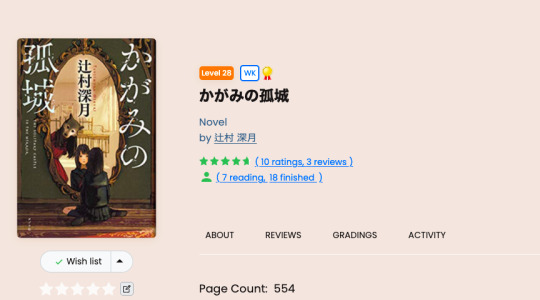
☞Caveat: don't feel discouraged if you found a book to be difficult even though it didn't seem like it would be. Everyone thrives in different areas and different subjects. Just because something was graded at N5 and you had difficulties with it at N3 doesn't mean anything--it might mean that it wasn't something to your liking. There are some series that I have difficulty with because of pacing or because I lacked interest in it.
❀ If you're worried about reading a book or series on your own and you're looking for friends to read and discuss about it with, come join us over on the discord and propose it as an option in the bookclub.
㉄ Can't find a particular book or series that you're looking for on the website? You can request for it to be added here.
★ The website is also equipped to let you "organize" your library into categories and track your reading progress. Additionally, you can make your library and reading progress private if you don't want anyone to see. As I'm currently using this blog to be as open as I can possibly be on my language learning journey, mine is made public. Feel free to check me out on the website.
★This is not sponsored, but if you receive a welcome message from Brandon, the owner and creator of the website, tell him that maobuchou sent you (that's me! ☺️). Brandon is really nice, so if there's anything that you're confused about or if you have suggestions for the website, he has an option for you to contact him.
★If you're interested in seeing what I'm currently reading, what I'm interested in reading next, and what I've graded thus far, click here to follow me (I'll follow back). Following other users allows you take a peek at what books they're reading. I also update my profile to say what book is also being read in the discord bookclub.
There will be more posts to come in the future about ways to become comfortable with reading in your target language.
460 notes
·
View notes